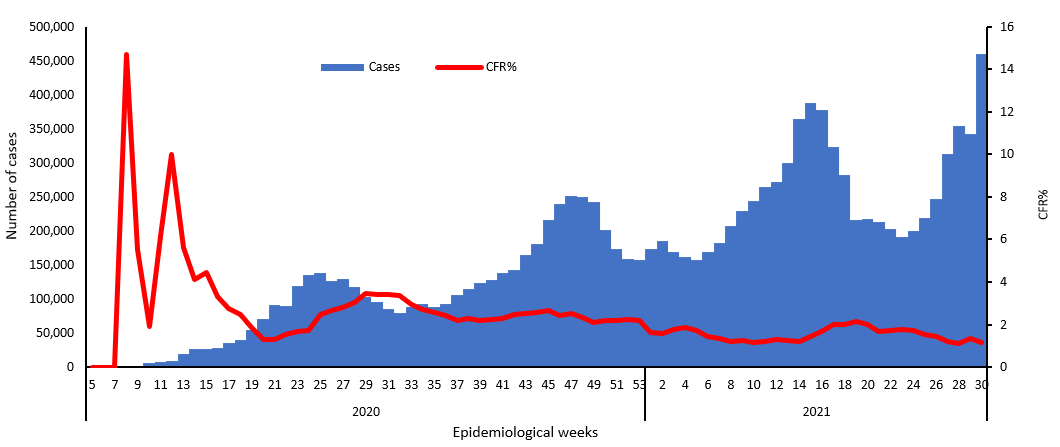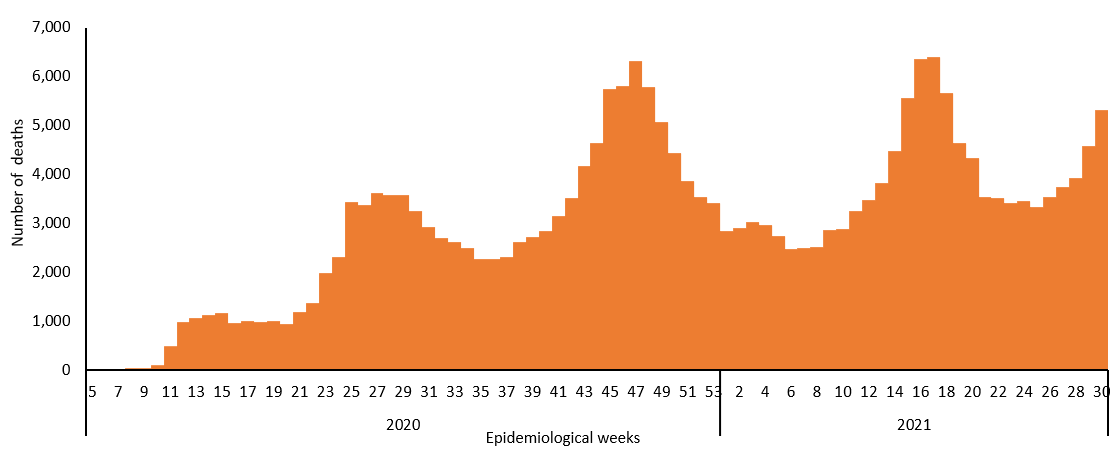The coronavirus disease COVID-19 continues to spread at the regional and global levels. As of 31 July 2021, the global cumulative incidence reached 197 195 568 reported cases and 4 210 201 associated deaths with a case fatality ratio (CFR) of 2.1%. Meanwhile, the 22 countries of the Eastern Mediterranean Region (EMR) have reported a total of 12 608 611 cases, which represent about 6.4% of the global count, with 236 576 associated deaths (CFR 1.9%). Most countries in the Region are in the community transmission phase.
Since the beginning of the outbreak, the country that has reported the highest number of total cases in the Region is Islamic Republic of Iran (3 871 008 cases; 30.7% of the Region’s total), followed by Iraq (1 626 599; 12.9%) and Pakistan (1 034 837; 8.2%). Islamic Republic of Iran also reported the highest number of total associated deaths (90 630; CFR 2.3%) followed by Pakistan (23 422; CFR 2.3%) and Tunisia (20 067; CFR 3.4%). The highest CFRs were reported by Yemen (19.5%) followed by Sudan (7.5%), while the lowest CFRs were reported by Qatar (0.27%), United Arab Emirates (0.29%) and Bahrain (0.51%).
During epidemiological week 30, the Region reported an increase in cases of 34.5% when compared to the previous week (459 477 cases compared to 341 701 cases). Similarly, an increase of 16.1% was observed for associated deaths (5313 deaths compared to 4576 deaths).
Libya, Morocco, and Islamic Republic of Iran reported a relative increase in COVID-19 activity in week 30. The cumulative number of cases increased from 233 449 to 253 436 in Libya (an 8.6% weekly increase), from 575 162 to 623 528 in Morocco (an 8.4% weekly increase) and from 3 664 286 to 3 871 008 in Islamic Republic of Iran (a 5.6% weekly increase). Tunisia, Libya and Afghanistan had the largest relative increase in deaths.
In terms of testing, a total of 191 158 586 laboratory PCR tests were conducted since the start of the outbreak across the Region including 5 180 698 tests in week 30, which shows an 31.1% increase compared to the previous week when 3 951 794 tests were conducted. The highest number of PCR tests were reported from United Arab Emirates (65.9 million), followed by Islamic Republic of Iran (25.9 million) and Saudi Arabia (25 million). The United Arab Emirates and Bahrain are performing the highest rates of testing per capita (6598/1000 and 3116/1000, respectively). The average positivity rate for the Region is 6.6%. WHO recommends a positivity rate of around 3–12% as a general benchmark indicating adequate testing, which was achieved in most countries of the Region.
Meanwhile, COVID-19 vaccination continues across the Region. The total number of doses administered so far in the 22 countries is 137 284 568. Pakistan has administered the highest number of doses at 29 648 055 followed by Saudi Arabia at 26 725 748 and Morocco at 23 755 510. On the other hand the total number of administrated doses in Sudan is 810 560, in Libya is 546 745, in Yemen is 311 483, in Somalia is 249 790, in Syria is 108 276 and in Djibouti is 26 796.*
Supporting countries in the Region
The regional incident management support team continues to coordinate the response and provide technical support to countries and partners in the Region in the areas of coordination and partnership, surveillance, laboratory capacity, clinical management, infection prevention and control, risk communication and community engagement, points of entry according to the International Health Regulations (2005), research, health systems, and essential health services among others.


For more data from the Region, please visit the COVID-19 dashboard.
*The data on vaccination is obtained from a number of sources including media reports and country websites for ministries of health.
Subscribe to the monthly infectious hazard preparedness newsletter of WHO’s Health Emergencies Programme for latest data and analysis on epidemic- and pandemic-prone diseases, as well as news on outbreak preparedness and response within WHO’s Eastern Mediterranean Region.


